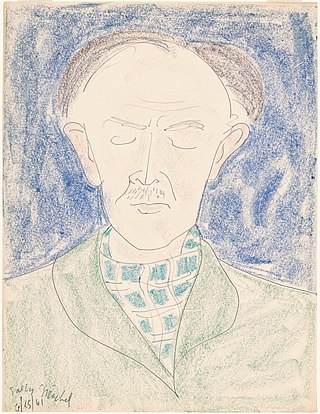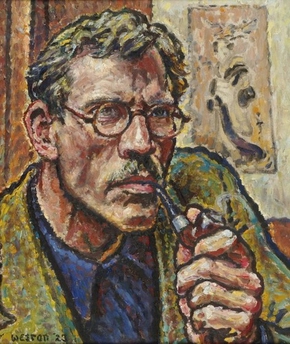
Visual art of the United States or American art is visual art made in the United States or by U.S. artists. Before colonization, there were many flourishing traditions of Native American art, and where the Spanish colonized Spanish Colonial architecture and the accompanying styles in other media were quickly in place. Early colonial art on the East Coast initially relied on artists from Europe, with John White the earliest example. In the late 18th and early 19th centuries, artists primarily painted portraits, and some landscapes in a style based mainly on English painting. Furniture-makers imitating English styles and similar craftsmen were also established in the major cities, but in the English colonies, locally made pottery remained resolutely utilitarian until the 19th century, with fancy products imported.

George Catlin was an American lawyer, painter, author, and traveler, who specialized in portraits of Native Americans in the American frontier.

Albert Bierstadt was a German American painter best known for his lavish, sweeping landscapes of the American West. He joined several journeys of the Westward Expansion to paint the scenes. He was not the first artist to record the sites, but he was the foremost painter of them for the remainder of the 19th century.

Milton Clark Avery was an American modern painter. Born in Altmar, New York, he moved to Connecticut in 1898 and later to New York City. He was the husband of artist Sally Michel Avery and the father of artist March Avery.

Julian Alden Weir was an American impressionist painter and member of the Cos Cob Art Colony near Greenwich, Connecticut. Weir was also one of the founding members of "The Ten", a loosely allied group of American artists dissatisfied with professional art organizations, who banded together in 1898 to exhibit their works as a stylistically unified group.

Albert Pinkham Ryder was an American painter best known for his poetic and moody allegorical works and seascapes, as well as his eccentric personality. While his art shared an emphasis on subtle variations of color with tonalist works of the time, it was unique for accentuating form in a way that some art historians regard as modernist.

Robert Laurent was a French-American modernist figurative sculptor, printmaker and teacher. His work, the New York Times wrote,"figured in the development of an American sculptural art that balanced nature and abstraction." Widely exhibited, he took part in the Whitney's 1946 exhibition Pioneers of Modern Art. Credited as the first American sculptor to adopt a "direct carving" sculpting style that was bolder and more abstract than the then traditional fine arts practice, which relied on models, Laurent's approach was inspired by the African carving and European avant-garde art he admired, while also echoing folk styles found both in the U.S. and among medieval stone cutters of his native Brittany. Best known for his virtuoso mastery of the figure, Laurent sculpted in multiple media, including wood, alabaster, bronze, marble and aluminum. His expertise earned him major commissions for public sculpture, most famously for the Goose Girl for New York City's Radio City Music Hall, as well as for Spanning the Continent for Philadelphia's Fairmount Park. After the Depression, he was also the recipient of several Works Progress Administration (WPA) Federal Art Project commissions under the New Deal, including a bas-relief called Shipping for the exterior of Washington, D.C.'s Federal Trade Commission Building, commissioned by the Treasury Department’s Section of Fine Arts in 1938.

Raphaelle Peale is considered the first professional American painter of still-life.

Arthur Bowen Davies was an avant-garde American artist and influential advocate of modern art in the United States c. 1910–1928.

Sam Gilliam was an American color field painter and lyrical abstractionist artist. Gilliam was associated with the Washington Color School, a group of Washington, D.C.-area artists that developed a form of abstract art from color field painting in the 1950s and 1960s. His works have also been described as belonging to abstract expressionism and lyrical abstraction. He worked on stretched, draped and wrapped canvas, and added sculptural 3D elements. He was recognized as the first artist to introduce the idea of a draped, painted canvas hanging without stretcher bars around 1965. This was a major contribution to the Color Field School and has had a lasting impact on the contemporary art canon. Arne Glimcher, Gilliam's art dealer at Pace Gallery, wrote following his death that "His experiments with color and surface are right up there with the achievements of Rothko and Pollock."
Gene Davis was an American Color Field painter known especially for his paintings of vertical stripes of color.

Harold Weston was an American modernist painter, based for many years in the Adirondack Mountains, whose work moved from expressionism to realism to abstraction. He was collected by Duncan Phillips, widely exhibited in the 1920s and 1930s, and painted murals under the Treasury Relief Art Project for the General Services Administration. In later life he was known for his humanitarian food relief work during World War II and his arts advocacy that led to the passage of the National Endowment for the Arts and Humanities Act of 1965. Weston's most recent museum exhibition was at the Shelburne Museum in Vermont, and his most recent gallery exhibition was at Gerald Peters Gallery in New York City.

Louis Schanker was an American abstract artist.

William Henry Rinehart was a noted American sculptor. He is considered "the last important American sculptor to work in the classical style."

John Mix Stanley was an artist-explorer, an American painter of landscapes, and Native American portraits and tribal life. Born in the Finger Lakes region of New York, he started painting signs and portraits as a young man. In 1842 he traveled to the American West to paint Native American life. In 1846 he exhibited a gallery of 85 of his paintings in Cincinnati and Louisville. During the Mexican–American War, he joined Colonel Stephen Watts Kearney's expedition to California and painted accounts of the campaign, as well as aspects of the Oregon Territory.

Elizabeth Nourse was a realist-style genre, portrait, and landscape painter born in Mt. Healthy, Ohio, in the Cincinnati area. She also worked in decorative painting and sculpture. Described by her contemporaries as "the first woman painter of America" and "the dean of American woman painters in France and one of the most eminent contemporary artists of her sex," Nourse was the first American woman to be voted into the Société Nationale des Beaux-Arts. She also had the honor of having one of her paintings purchased by the French government and included in the Luxembourg Museum's permanent collection. Nourse's style was described by Los Angeles critic Henry J. Seldis as a "forerunner of social realist painting." Some of Nourse's works are displayed at the Cincinnati Art Museum.

Sarah Miriam Peale was an American portrait painter, considered the first American woman to succeed as a professional artist. One of a family of artists of whom her uncle Charles Willson Peale was the most illustrious, Sarah Peale painted portraits mainly of Maryland, Pennsylvania and Washington, D.C. notables, politicians, and military figures. Lafayette sat for her four times.

John Wood Dodge (1807–1893) was an American painter. He is best known for his portrait miniatures of Southerners.

James Alexander Simpson was an American painter, best remembered today for his long association with Georgetown University.


















